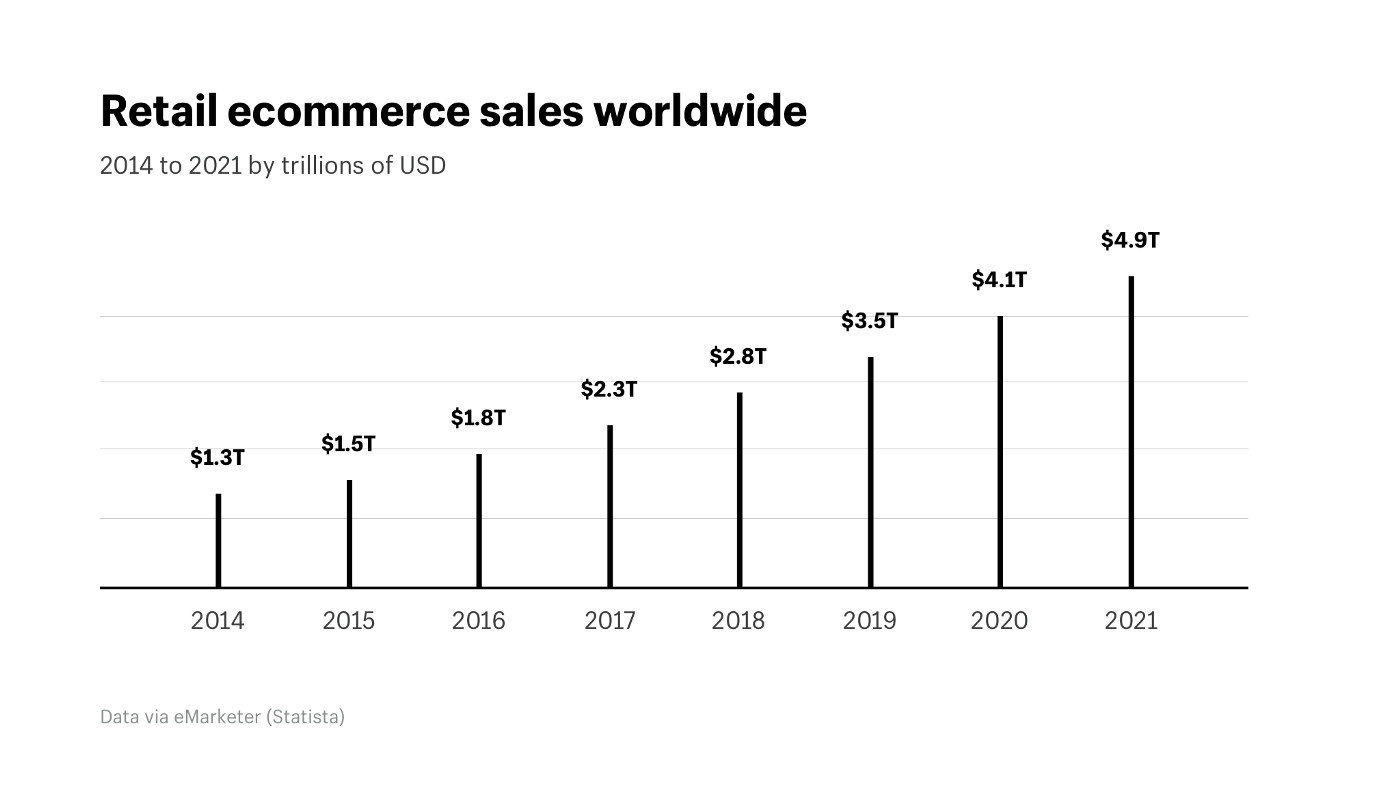A Failed Experiment in E-commerce and Marketing
E-commerce is growing exponentially; one day everything's going to be online. I think the following graph gives you a pretty good idea:

Total ecommerce spending per customer is something like $2000 per customer in the US, and yet ecommerce only accounts for only 13% of all USA retail sales (2017). The valuations for these ecommerce shops and platforms are huge. The overnight successes of some of these companies are ridiculous; globalization has made it almost trivial for someone in the US to open a store and saturate a product.
I launched a product, (spoilers: lost money). And I spent some time the past three-ish months reading stuff on ecommerce, online advertisement, and conversion strategies.
- Something like 95% of everything we buy is due to interruption marketing. We see something that has some perceived value and we just buy it.
- You can target people that are most likely to buy your product because large aggregators (google, facebook, tiktok, etc) make extremely accurate inferences about you.
If you think these groups as systems (people buying, people selling), there are implications and business opportunities:
- Crowd attentions can be hacked to get groups of people to do or think a certain thing. Could be anything.
- There is a high demand job market for people who can create value in the ecommerce supply chain. These people either work for big product companies or advertisement agencies.
- Better conversion rates mean higher profit margin. So these platforms (google, facebook) that collect data and show ads have immense value.
- Sidenote: Pinterest stock is probably really good to invest in: their conversion per cost rates are super good.
- People will find ways to centralize the online shopping experience.
- People will find ways to reduce the length of the supply chain.
- A manufacturer/seller paradigm shift. The seller will no longer place orders; the manufacturer will have warehouses with supply and people choose what they want to sell.
Big and often interesting problems in this space often try to answer the question: how do we get people to buy all this shit. A disproportionate value is captured in the demand-increase step (advertisement, etc) as opposed to the actual product itself.
Experiment
Before I confuse you with my tangents, my thesis statement is this: online marketing is effective, but our experiment turned out to be not profitable. My girlfriend and I worked on some of this together. In the end, we earned a bit over 150 dollars and spent around 800 (around 300 recurring costs), which means that we could expect to lose 1 dollar for every 2 dollars spent. Here were our expenses and approximate amounts:
| Expense | Amount ($) |
|---|---|
| Shopify Monthly Fee | 30 per month |
| Product Samples | 5 |
| Canva Subscription (design for instagram/fb/shopify, etc) |
20+ |
| Domain Name | 15 |
| Facebook Ads | 300 |
| Fiverr Cost (making ad videos) Made 4 videos for 3 campaigns |
75 |
| Shipping Costs | 3 per |
| Actual Product Cost (x300) | 300 |
We also tried a bunch of other things that kind of were inconvenient or didn't work out. Some other sunk costs: Amazon seller fee (40 per month), Invideo subscription (15), tiktok ads (50), etc. Consider these expenses as education fees.
In earnest, this could have been profitable: if we went through the process again, but with a better product and more streamlined advertisements, there were a myriad of things to maximize the spent per revenue ratio. Here's the product. (I was suprised people would buy this product at all tbh.)
The main reason for the failure was that we sold a shitty car-sticky-thing product by sticking your phone to your car. This market is absolute trash tier. The conversion rate is worse than normal. Here are some screenshots:


Consider these niche highly-marketable high-profit margin products and ignore branding for a moment:
- https://indestructibleshoes.com/
- https://teenage.engineering/products/audio
- https://www.apple.com/apple-watch-series-6/
Here are the reasons why these products work:
- Clear target audiences, which is going to cost a lot less per conversion. Advertisement platforms can learn over time to capture the most effective audiences, but in the end, for things like car-sticky-thing, it's still going to be maximizing the profit from a relatively general audience.
- High profit margins. Something like 80% to 90% of indestructible shoes revenue becomes profit. Teenage engineering radio is literally a 600 dollar radio. Teenage engineering can spend 300 dollars to convert a customer and still make bank. In contrast, only something like 9 dollars is profit for these car-sticky-things.
- Marketability. This is more of an emergent property, but it's easy to design targeted ads. Branding and good site design goes a long way. In contrast, these car-sticky-things are not branded, nor does the product have any competitive advantage.
Interestingly enough, these are also some traits VCs look for in tech companies. Anyways, we also took the risk of buying wholesale; dropshipping times from China were like a month due to COVID-19. Other things that weren't mentioned: facebook business, ads, pixels, shopify, case-studies, more bespoke advertising avenues, B2B, etc. It's a rabbit hole.
It's really costly to run these experiments. However, the value of running these marketing experiments should not be understated. Both marketing strategies and products change over time, and it'll be prudent to be aware.
Post publishing comments:
- Found this informative summary, https://10ecommercetrends.com/, mentions a lot of things I didn't, and has a lot of specifics.